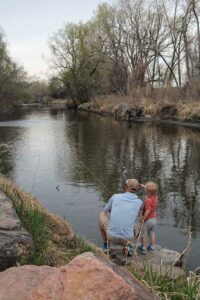In 1956 Parshall also identified a more challenging water issue:
“Examining the water problem we find the curve representing the population is rising and the curve showing the water supply is gradually dropping…People are on the move to live in Colorado, farmers are to be supplied with water, industry is expanding to use more water and we are going down hill on water supply.”
 He was prophetic: The Poudre valley’s cities and industries continued to expand. Growing urban centers needed water as did farmers.
He was prophetic: The Poudre valley’s cities and industries continued to expand. Growing urban centers needed water as did farmers.
As water demand continued to grow, some feared it could outpace even the generous addition of water made available by the C-BT project. In the 1950s, new economic activities such as meatpacking, the manufacture of photographic equipment, the brewing of beer, and new computer technology competed for Poudre water. Gravel mining and housing developments changed the character of the river’s corridor. Population growth transformed colleges into universities. Leisure pursuits challenged agriculture’s role as the leading revenue source in the region and state. Newcomers moved in, suburbs replaced farms, and water rights were acquired by municipalities to supply urban households instead of rural lands.
 During the 1960s and 1970s, Americans began re-evaluating their understanding of the natural world, focusing on environmental preservation and protection. Locally, biologists identified pollution resulting from dumping sewage and industrial waste, farm fertilizer, and pesticide runoff in the Poudre. Old canals that passed through neighborhoods attracted debris, and water seeped into basements. Some citizens viewed water structures as manufactured hindrances to an otherwise natural river.
During the 1960s and 1970s, Americans began re-evaluating their understanding of the natural world, focusing on environmental preservation and protection. Locally, biologists identified pollution resulting from dumping sewage and industrial waste, farm fertilizer, and pesticide runoff in the Poudre. Old canals that passed through neighborhoods attracted debris, and water seeped into basements. Some citizens viewed water structures as manufactured hindrances to an otherwise natural river.
In the 1970s, the Poudre became a focus for outdoor recreation. Paved trails were built along its banks, attracting photographers, walkers, joggers, and bicyclists, while the gentle flow of the river invited tubers, waders, and fishermen.
In 1986, the mountainous 75-mile upper section of the Poudre was designated a National Wild and Scenic River. The “Wild and Scenic” status prohibited dams on that section of the river; however, the bill reflected a compromise. Congress omitted the lower seven miles within the Poudre Canyon, leaving that section available for future water projects.
The search for additional sources of water and storage continues. The Northern Integrated Supply System (NISP) seeks to address future demands. The regional project includes municipalities and water districts that hope to increase the capacity and reliability of water.



